Abstract
The mechanism of the anticyclonic eddy's shedding from the Kuroshio bend in Luzon Strait has been studied using a nonlinear 2 1/2 layer model, in a domain including the North Pacific and South China Sea. The model is forced by steady zonal wind in the North Pacific. Energy analysis is adopted to detect the mechanism of the eddy shedding. Twelve experiments with unique changes of wind forcing speed (to obtain different Kuroshio transports at Luzon Strait) were performed to examine the relationship between the Kuroshio transport (KT) and the eddy shedding events. In the reference experiment with KT of 22.7 Sv (forced with zonal wind idealized from the annual mean wind stress from the COADS data set), the interval of eddy shedding is 70 days and the shed eddy centers at (20°N, 117.5°E). When the Kuroshio bend extends westward, the southern cyclonic perturbation grows so rapidly as to form a cyclonic eddy (18.5°N, 120.5°E) because of the frontal instability in the south of the Kuroshio bend. In the evolution of the cyclonic eddy, it cleaves the Kuroshio bend and triggers the separation of the anticyclonic eddy. In statistical terms, anticyclonic eddy shedding occurs only when KT fluctuates within a moderate range, between 21 Sv and 28 Sv. When the KT is larger than 28 Sv, a stronger frontal instability south of the Kuroshio bend tends to generate a cyclonic eddy of size similar to the width of the Luzon Strait. The bigger cyclonic eddy prevents the Kuroshio bend from extending into the SCS and does not lead to eddy shedding. On the other hand, when the KT decreases to less than 21 Sv, the frontal instability south of the Kuroshio bend is so weak that the size of corresponding cyclonic eddy is smaller than half the width of the Luzon Strait. The cyclonic eddy, lacking power, fails to cleave the Kuroshio bend and cause separation of an anticyclonic eddy; as a result, no eddy shedding occurred then, either.
Similar content being viewed by others
References
Farris, A. and M. Wimbush (1996): Wind-induced Kuroshio intrusion into the South China Sea. J. Oceanogr., 52, 771–784.
Hayashi, Y. Y. and W. R. Young (1987): Stable and unstable shear modes of rotating parallel flows in shallow water. J. Fliud Mech., 184, 477–540.
Jia, Y. and Q. Liu (2004): The eddy shedding from the Kuroshio bend at Luzon Strait. J. Oceanogr., 60, 1063–1069.
Li, L. and B. Wu (1989): A Kuroshio loop in South China Sea?— On circulations of the north-eastern South China Sea. J. Oceanogr. of Taiwan Strait., 8, 89–95 (in Chinese with English abstract).
Li, L., W. D. Nowlin, Jr. and J. L. Su (1998): Anticyclonic rings from the Kuroshio in the South China Sea. Deep-Sea Res. I, 45, 1469–1482.
McCreary, J. P. and Z. Yu (1992): Equatorial dynamics in a 2 1/ 2∼layer model. Prog. Oceanogr., 29, 61–132.
Metzger, E. J. and H. E. Hurlburt (2001): The nondeternimistic nature of Kuroshio penetration and eddy shedding in the South China Sea. J. Phys. Oceanogr., 31, 1712–1732.
Miyata, M. (1981): A criterion for barotropic instability at the equator. Tropical Ocean-Atmosphere Newsletter, 5, 12–16.
Nitani, H. (1972): Beginning of the Kuroshio. p. 129–163. In Kuroshio, Physical Aspects of the Japan Current, ed. by H. Stommel and K. Yoshida, University of Washington.
Ripa, P. (1983): General stability conditions from zonal flows in a one-layer model on the β-plane or the sphere. J. Fliud Mech., 126, 463–487.
Sheremet, V. A. (2001): Hysteresis of a western boundary current leaping across a gap. J. Phys. Oceanogr., 31, 1247–1259.
Author information
Authors and Affiliations
Corresponding author
Rights and permissions
About this article
Cite this article
Jia, Y., Liu, Q. & Liu, W. Primary Study of the Mechanism of Eddy Shedding from the Kuroshio Bend in Luzon Strait. J Oceanogr 61, 1017–1027 (2005). https://doi.org/10.1007/s10872-006-0018-x
Received:
Revised:
Accepted:
Issue Date:
DOI: https://doi.org/10.1007/s10872-006-0018-x




